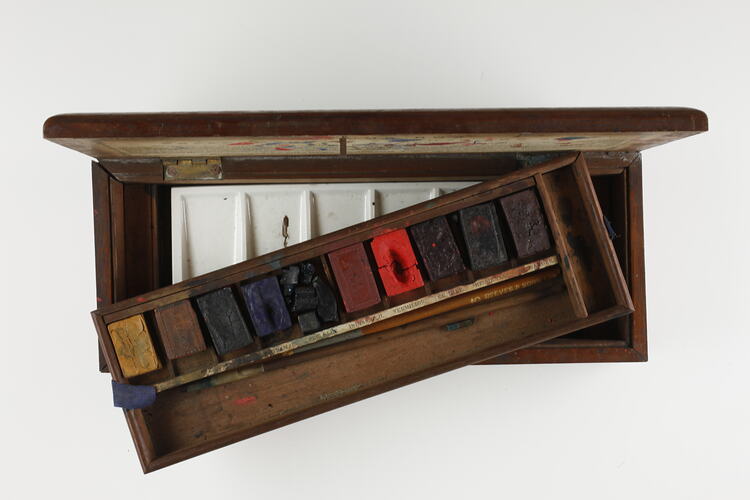Summary
Alternative Name(s): Paintbox, Watercolour Box, Colour Box, Paint Palette
Rectangular wooden paint box containing pallette of watercolour paints. Made by Charles Roberson & Co, no. 99 Long Acre, London, W.C., probably in the 1860s. Inside the lid of the box, a paper label indicates that it has been 'awarded by the Department of Science and Art' and provides suggestions on the use of colours.
Roberson's product list, enclosed in the paint box, indicates that it makes 'water colours in cakes', 'moist water colours in china pans and tubes'; 'water colours in boxes'; 'chinese and constant white'; boxes of colours and materials 'for illuminating'; 'sketching boxes'; drawing paper; 'cartoon papers'; chalks and crayons; brushes and pencils; oil painting medium; oil colours in tubes; canvas for oil painting; panels and millboards; lead and 'polished' pencils; 'academy' boards; 'prepared paper'; easels; 'french lady figures'; varnishes and oils; etching and copperplate printing materials, and presses. The product list indicates that Roberson & Company won prizes for drawing materials in the international exhibitions of 1851 and 1862, providing an approximate date for the paint box.
Spectral analysis of the 'brown madder' paint by the museum showed it to actually be a cheaper copper-based colour.
The paint box was acquired by Museum Victoria from Canada. Its provenance is otherwise unknown.
Physical Description
Rectangular wood paint box containing a pallette of watercolour paints. Paint box is red-tinged varnished wood (possibly cedar), hinged, with paper manufacturer's label adhered inside lid. Inside box the paint pallette is a wooden tray divided into compartments. Ten compartments fit cubes of watercolour paint, with a printed label adjacent naming the colours within. All cubes show signs of having been used; one is cracked and another broken into pieces. Below and to the right are compartments for brushes, nibs and other artists' needed. The pallette has a blue cloth tag on either end for lifting the tray. When it is lifted from the box, a white ceramic colour mixing tray is revealed. It contains six hollows for mixing paint, two of which have remnant colours in them (green/yellow and black). Ink has been spilled in the bottom of the box. The underside of the box has the remnants of a coarse weave green fabric glued on, probably to prevent the box scratching surfaces. The box also contains a printed paper sheet listing the manufacturer's products - torn along folds, and with extensive foxing - and two used paint brushes with wooden handles, one inscribed 'Reeves & Sons Ltd'.
Significance
The paint box is considered significant as a representative example of 19th century artists' supplies. The particular manufacturer of the box adds to its significance. Charles Roberson (1799-1876) is considered 'one of the most important colourmen in London in the nineteenth century', and the Fitzwilliam Museum in the Hamilton Kerr Institute at the University of Cambridge holds a significant archive documenting the operations of Charles Roberson & Co. and its relationships with customers and suppliers. The archive is said to be the largest artists' colourman's archive in the United Kingdom, covering the period from 1820 to 1944. It includes information on the materials and techniques of many of the leading 19th and 20th century British artists including 'all the artist members of the Pre-Raphaelite Brotherhood, Leighton, Alma Tadema, Watts, Whistler, Tissot, William Morris and many other members of the Royal, Cambrian, Hibernian & Scottish Academies'.
Charles Roberson opened his first shop in Long Acre, London, in 1819, selling artists' materials. His business soon became 'one of the most influential colour houses in London, its customers spanning the social spectrum from Queen Victoria to theatrical scene painters'. Royal Academicians were included on their account books, as well as leading designers of the period and members of the social elite. The business moved to 99 Long Acre in 1853 (where it was situated when the Museum's paint box was made), and remained there until 1937.
The significance of the box label indicating that it has been 'awarded by the Department of Science and Art' is unknown.
More Information
-
Collecting Areas
-
Acquisition Information
Purchase
-
Place & Date Made
Long Acre, London, England, Great Britain, 1860-1870
-
Inscriptions
Inside lid, a paper label is adhered, printed with extensive text. It is headed 'COLOUR BOX / AWARDED BY / THE DEPARTMENT OF SCIENCE AND ART / SUGGESTIONS ON THE USE OF COLOURS'. A loose white paper sheet, printed, is inscribed: 'ROBERSON & COMPY / Manufacturers of Water and Oil Colours, / MATERIALS FOR DRAWING AND PAINTING, / No.99, LONG ACRE, LONDON, W.C.'. Lists of products and prices follow, with individual names for colours, etc. They are divided into 'WATER COLOURS IN CAKES' and 'MOIST WATER COLOURS IN CHINA PANS AND TUBES'; 'WATER COLOURS IN BOXES'; 'CHINESE AND CONSTANT WHITE'; 'BOXES OF COLOURS AND MATERIALS FOR ILLUMINATING'; 'SKETCHING BOXES'; 'DRAWING PAPER'; CARTOON PAPERS, ETC'; 'CHALKS AND CRAYONS'; 'BRUSHES AND PENCILS'; 'ROBERSON'S CELEBRATED MEDIUM FOR OIL PAINTING'; 'OIL COLOURS IN TUBES'; 'PREPARED CANVAS FOR OIL PAINTING'; PREPARED PANELS AND MILLBOARDS'; 'ROBERSON'S PREPARED LEAD PENCILS'; 'POLISHED PENCILS'; 'ACADEMY BOARDS, AND PREPARED PAPER'; 'EASELS'; 'FRENCH LADY FIGURES'; VARNISHES, OILS, &c'; Etching and Copperplate Printing Materials, and Presses for ditto'.
-
Classification
-
Category
-
Discipline
-
Type of item
-
Overall Dimensions
243 mm (Width), 97 mm (Depth), 47 mm (Height)
Measured with box closed. When box open, height is 128 mm.
-
Dimensions
244 mm (Length), 98 mm (Width), 45 mm (Height)
Measurement From Conservation. Dimensions are of box closed. When open box height is approximately 128 mm.
-
References
Information on the Roberson Archive at the University of Cambridge: [Link 1] accessed 12 Oct 2011. See also 'British artists' suppliers, 1650-1950', National Portrait Gallery, [Link 2] accessed 12 Oct 2011.
-
Keywords
Art Supplies, Artists, Exhibitions: London International, Great Exhibition, 1851, Exhibitions: London International, Industry & Art, 1862

